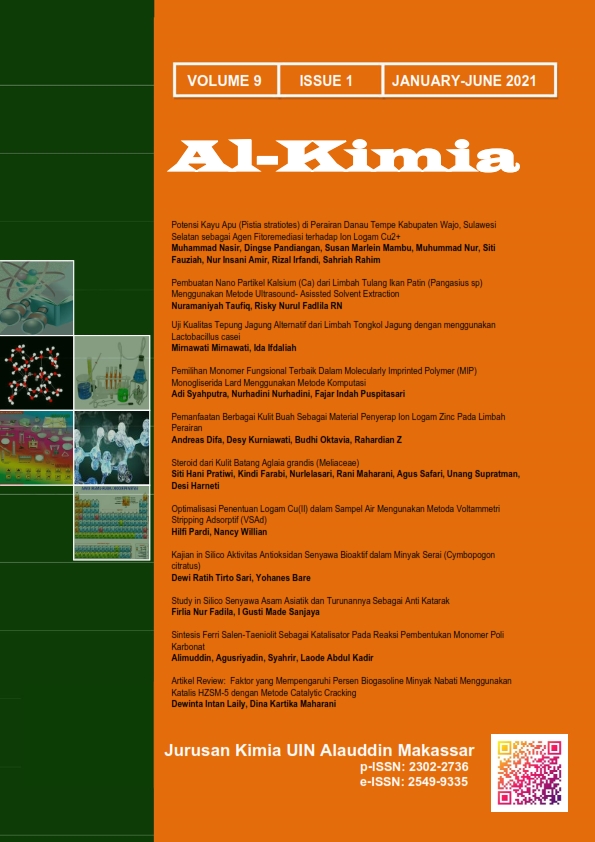Pembuatan Nano Partikel Kalsium (Ca) dari Limbah Tulang Ikan Patin (Pangasius sp) Menggunakan Metode Ultrasound- Asissted Solvent Extraction
Abstrak
Management of fish bones asa a source of calcium must be converted into a smaller form so that it is easily absorbed by the body into nanocalsium. In this case, fish bones are seen as giving a lot of advantages because fish are easier to get. The purpose of this study was to utilize catfish(Pangasius Sp) bones as the main ingredient for the manufacture of nanocalcium and extract fish bone lead using the Ultrasonic-Assisted Solvent Extraction method. This research method is characterization . of cat fish bone waste making nano particles using the Ultrasonic-Assisted solvent method, and characterized SEM-EDX. The result showed that the characteristic of catfish bone powder waste were 10,35 % water content, 44,29 % ash content, 1,849 fiber content, 11,47 % fat content, 0,27% protein content, and carbohydrates 33,62%, and SEM result for the morphological size 5.000x magnification, the particle diameter 3111,08 nm and EDX was 6 % purity of calcium (Ca).
##plugins.generic.usageStats.downloads##
Referensi
Adawiyah, A., & Selviastuti, R. 2014. Serburia Suplemen Tulang Ikan Bandeng Dengan Cangkang Kapsul Alginat Untuk Mencegah Osteoporosis. Jurnal Ilmiah Mahasiswa Fakultas Kesehatan Masyarakat Universitas Diponegoro, 4(1), 97088.
Afrinis, N., Besti, V., & Anggraini, H. D. 2018. Formulasi dan Karakteristik Bihun Tinggi Protein dan Kalsium dengan Penambahan Tepung Tulang Ikan Patin (Pangasius Hypopthalmus) Untuk Balita Stunting. Media Kesehatan Masyarakat Indonesia, 14(2), 157.
Anggraeni, P. dwi, Darmanto, Y. S., & Fahmi, A. F. 2017. Pengaruh Penambahan Nanokalsium Tulang Ikan Yang Berbeda Terhadap Karakteristik Beras Analog Umbi Gembili (Dioscorea Esculenta) Dan Rumput Laut Eucheuma Spinosum. Journal of Food Quality, 1(1), 55–64.
Darmawangsa, J., Tahapari, E., & Pamungkas, W. 2016. Performa Benih Ikan Patin Siam Pangasianodon hypophthalmus (Sauvage, 1878) dan Pasupati (Pangasius sp.) dengan Padat Penebaran yang Berbeda pada Pendederan Sistem Resirkulasi. Jurnal Iktiologi Indonesia, 16(3), 243–250.
Gunawan, & Khalil, M. 2014. Analisa proksimat formulasi pakan pelet dengan penambahan bahan baku hewani yang berbeda. Acta Aquatica, 2(1), 23–30.
Handayani, H., & Sriherfyna, F. H. 2016. Ekstraksi Antioksidan Daun Sirsak Metode Ultrasonic Bath ( Kajian Rasio Bahan : Pelarut Dan Lama Ekstraksi ) Antioxidant Extraction of Soursop Leaf with Ultrasonic Bath ( Study of Material : Solvent Ratio and Extraction Time ). Jurnal Pangan Dan Agroindustri, 4(1), 262–272.
Iskandar, R., & Fitriadi, S. 2017. Analisa Proksimat Pakan Hasil Olahan Budidaya Ikan Di Kabupaten Banjar Kalimantan Selatan. Ziraa"ah, 42, 65–68.
Ikhsan, M., Muhsin, M., & Patang, P. 2018. Pengaruh Variasi Suhu Pengering Terhadap Mutu Dendeng Ikan Lele Dumbo (Clarias gariepinus). Jurnal Pendidikan Teknologi Pertanian, 2(2), 114.
Keil, F. J. (Ed). 2007. Modelling of Process intensification . Germany: Wiley-VCH, Weinheim.
Meiyasa, F., Kristen, U., Wacana, W., Tarigan, N., Kristen, U., & Wacana, W. 2020. Pemanfaatan Limbah Tulang Ikan Tuna ( Thunnus Sp .) Sebagai. Jurnal Teknologi Pertanian Andalas, 24(1), 67–76.
Prinaldi, W, F., Suptijah, P., & Uju. 2018. Karakteristik Sifat Fisikokimia Nano-Kalsium Ekstrak Tulang ( Thunnus Albacares ). 21(3), 385–395.
Poernomo, N., Utomo, N. B. P., & Azwar, Z. I. 2015. Pertumbuhan dan kualitas daging ikan patin siam yang diberi kadar protein pakan berbeda. Jurnal Akuakultur Indonesia, 14(2), 104–111.
Suarsa, I. W., Bawa Putra, A. ., Santi, S. R., & Faruk, A. 2020. Produksi Tepung Tulang Ikan Tuna ( Thunnus Sp) Dengan Metode Kering Sebagai Sumber Kalsium Dan Fosfor Untuk Pembuatan Biskuit Suarsa, I W 1) ; Bawa Putra, A.A 2) ; Sri Rahayu Santi 3) ; Abdul Faruk 4). 8(1), 19–28.
Julinawati, J., Marlina, M., Nasution, R., & Sheilatina, S. 2015. Applying Sem-edx Techniques to Identifying the Types of Mineral of Jades (Giok) Takengon, Aceh. Jurnal Natural Unsyiah, 15(2), 116128.
Zou, T. Bin, Xia, E. Q., He, T. P., Huang, M. Y., Jia, Q., & Li, H. W. 2014. Ultrasound-assisted extraction of mangiferin from mango (Mangifera indica L.) leaves using response surface methodology. Molecules, 19(2), 1411–1421.
Authors who publish with this journal agree to the following terms:
1) Authors retain copyright and grant the journal right of first publication with the work simultaneously licensed under a Creative Commons Attribution License that allows others to share the work with an acknowledgement of the work's authorship and initial publication in this journal.
2) Authors are able to enter into separate, additional contractual arrangements for the non-exclusive distribution of the journal's published version of the work (e.g., post it to an institutional repository or publish it in a book), with an acknowledgement of its initial publication in this journal.
3)Authors are permitted and encouraged to post their work online (e.g., in institutional repositories or on their website) prior to and during the submission process, as it can lead to productive exchanges, as well as earlier and greater citation of published work (See The Effect of Open Access).


